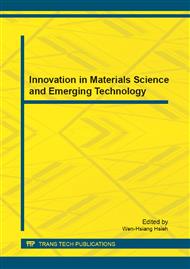p.314
p.320
p.325
p.330
p.334
p.339
p.344
p.349
p.354
Improving Fuel Cell Industry by Constructing Metrological Traceability
Abstract:
Due to the reality of ninety five percent dependency of energy-importing, the diversification of kinds and sources of fuel like crude oil is making crucial and environmental issues in Taiwan. Efficient and zero emission fuel cell is a promising power source and expected to play a major role in the future energy supply. According to the fuel cell roadmap of the Bureau of Energy, Taiwan Ministry of Economic Affairs, and the projected annual output will reach NTD 13,000 million in 2020, thus, a recognized specification and traceable metrology is necessary to maintain the product quality and trade equity once the market is emerged. In this paper, we review the current status of fuel cell development and standards in Taiwan and then propose a solid fuel cell metrology which can be traced to international standards.
Info:
Periodical:
Pages:
334-338
Citation:
Online since:
December 2011
Authors:
Keywords:
Price:
Сopyright:
© 2012 Trans Tech Publications Ltd. All Rights Reserved
Share:
Citation:


